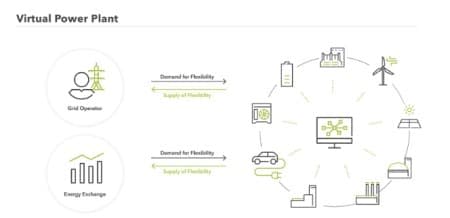Decentralized Energy Production Shakes Up Traditional Grids
Decentralized Energy Production Shakes Up Traditional Grids Yahoo Finance


The Evolution of Power Grids in the Renewable Revolution
The renewable revolution is forcing a major evolution in the way our power grids operate, as well as the way utilities regulate energy flow. While a major retooling of the system will be required to support the scale of the change brought on by the green energy transition, evolution has so far been slow and piecemeal. But that won’t be the case for long, as grids will be forced to update themselves to keep up with a more intensive and flexible energy flow – or risk collapse.
Challenges Faced by Power Grids
Grids will be faced with three major challenges as a result of the massive growth of renewable energy: a much higher demand for electricity, more variable energy sources, and a more decentralized grid. The demand on the energy grid will skyrocket as more and more services become electrified and plug-in electric vehicles proliferate. The renewable energy sources that will be expected to meet this demand, primarily wind and solar energy, are variable – meaning that, unlike fossil fuels, they don’t produce energy on demand. Instead, they depend on the weather and the seasons, and peak production times are often at odds with peak demand times. This will require a high degree of grid flexibility, as well as long-term energy storage capabilities. Finally, as energy markets become more and more diversified with new forms of energy production and new forms of energy producers (especially now that any home or business can produce solar power to sell back to the grid), the grid is becoming more and more decentralized.
The Role of Virtual Power Plants (VPPs)
As solar panels and home batteries become increasingly accessible and more widely adopted, the newly decentralized nature of power production will change the way grids and utilities work at a profound level. While this could cause some destabilizing shifts to an industry that was only prepared for a one-way flow of energy, from producer to consumer, it could also represent a crucial source of grid resilience. This is where Virtual Power Plants (VPPs) come in. VPPs represent a decentralized and diversified pool of producer-consumers (known as ‘prosumers’) working together to form a power plant without a home base. “Bundled together by the hundreds or thousands, [solar panels and home batteries] can also serve as a critical tool: they can be called on to supply vast amounts of power when grid supplies are stretched or store it when there is more solar and wind power than needed,” Reuters explains.


Source: Next Kraftwerke
The Future of VPPs
Some experts believe that VPPs – somewhat rare now – are positioned to become the new normal. The solar industry’s days as a “net metering type of industry” are “starting to be numbered,” according Jigar Shah, the director of the US Department of Energy’s Loan Programs Office, as quoted from the recent RE+ 2023 conference in Las Vegas. “Most solar systems come with batteries, and most are integrating smart panels,” he went on to say. “They’re integrating demand response and load control capabilities into the inverter controls.”
The potential uses of VPPs extends beyond distributed energy storage and production. VPPs could also include electric vehicle chargers, smart thermostats, and smart electric water heaters which could collectively function to improve energy efficiency – another key imperative of the global decarbonization movement. While it makes good economic sense to employ VPPs, says Shah, there’s also really no alternative. “Frankly, it is the only way for [electric utilities] to integrate all of the huge load that is coming their way.” As such, VPPs are already underway in large parts of the U.S. (especially via Duke Energy in the Carolinas) and in Puerto Rico.
And private sector actors aren’t the only ones taking notice – the United States Department of Energy anticipates lending support on the order of $100 million to advance VPPs, PV magazine reports. This is just a drop in the bucket, however, of the kind of monetary investments that will be required to bring energy grids up to speed. The International Energy Agency estimates that annual investments in energy sector infrastructure and technologies will need to quadruple from current levels to reach $4 trillion by just 2030 to enable the world to reach its goal of net-zero by 2050.
By Haley Zaremba for Oilprice.com
More Top Reads From Oilprice.com:
Read this article on OilPrice.com
SDGs, Targets, and Indicators
1. Which SDGs are addressed or connected to the issues highlighted in the article?
- SDG 7: Affordable and Clean Energy
- SDG 9: Industry, Innovation, and Infrastructure
- SDG 11: Sustainable Cities and Communities
- SDG 13: Climate Action
2. What specific targets under those SDGs can be identified based on the article’s content?
- SDG 7.2: Increase substantially the share of renewable energy in the global energy mix.
- SDG 9.1: Develop quality, reliable, sustainable, and resilient infrastructure.
- SDG 11.6: Enhance inclusive and sustainable urbanization and capacity for participatory, integrated, and sustainable human settlement planning and management.
- SDG 13.2: Integrate climate change measures into national policies, strategies, and planning.
3. Are there any indicators mentioned or implied in the article that can be used to measure progress towards the identified targets?
- Indicator for SDG 7.2: Share of renewable energy in the global energy mix.
- Indicator for SDG 9.1: Investment in infrastructure as a percentage of GDP.
- Indicator for SDG 11.6: Proportion of urban population living in slums or informal settlements.
- Indicator for SDG 13.2: Number of countries with integrated climate change plans.
SDGs, Targets, and Indicators
| SDGs | Targets | Indicators |
|---|---|---|
| SDG 7: Affordable and Clean Energy | 7.2: Increase substantially the share of renewable energy in the global energy mix. | Share of renewable energy in the global energy mix. |
| SDG 9: Industry, Innovation, and Infrastructure | 9.1: Develop quality, reliable, sustainable, and resilient infrastructure. | Investment in infrastructure as a percentage of GDP. |
| SDG 11: Sustainable Cities and Communities | 11.6: Enhance inclusive and sustainable urbanization and capacity for participatory, integrated, and sustainable human settlement planning and management. | Proportion of urban population living in slums or informal settlements. |
| SDG 13: Climate Action | 13.2: Integrate climate change measures into national policies, strategies, and planning. | Number of countries with integrated climate change plans. |
Behold! This splendid article springs forth from the wellspring of knowledge, shaped by a wondrous proprietary AI technology that delved into a vast ocean of data, illuminating the path towards the Sustainable Development Goals. Remember that all rights are reserved by SDG Investors LLC, empowering us to champion progress together.
Source: finance.yahoo.com

Join us, as fellow seekers of change, on a transformative journey at https://sdgtalks.ai/welcome, where you can become a member and actively contribute to shaping a brighter future.







